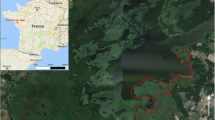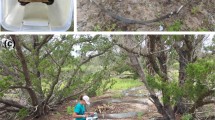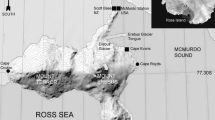Abstract
Animals usually build nests to provide protection, for themselves or their offspring, from adverse environmental conditions. However, different nest structures may be better at providing protection in different environments. The ability to adjust building behaviour and design of nests in response to variation in environmental conditions is therefore likely to be important in determining individual fitness. Here, we look at how the nests of three-spined stickleback (Gasterosteus aculeatus) males differ between still and flowing water conditions. Within flowing water treatments, we find that males select nesting sites with lower than average flow. We also find that nests built in flowing water are smaller and more streamlined than those built in still water. Nests built in flowing water contain more spiggin—an endogenous glycoprotein secreted by nesting males—per gramme of nest material than still water nests, though the absolute spiggin content of nests did not vary with flow regime. These results suggest that male sticklebacks may adjust nest-site selection and nest structure to suit environmental conditions in which they are building. Because flow regime is a factor that is often altered by anthropogenic activities, such as impoundment, channelization and abstraction, this study may also have implications for the conservation of freshwater fish populations.




Similar content being viewed by others
References
Asaeda T, Fu**o T, Manatunge J (2005) Morphological adaptations of emergent plants to water flow: a case study with Typha angustifolia, Zizania latifolia and Phragmites australis. Freshw Biol 50:1991–2001
Barber I, Ruxton GD (2000) The importance of stable schooling: do familiar sticklebacks stick together? Proc R Soc Lond B 267:151–155
Barber I, Nairn D, Huntingford FA (2001) Nests as ornaments: revealing construction by male sticklebacks. Behav Ecol 12:390–396
Biju SD (2009) A novel nesting behaviour of a treefrog, Rhacophorus lateralis in the Western Ghats, India. Curr Sci 97:433–437
Blais J, Rico C, Bernatchez L (2004) Nonlinear effects of female mate choice in wild threespine sticklebacks. Evolution 58:2498–2510
Bruton MN, Gophen M (1992) The effect of environmental factors on the nesting and courtship behaviour of Tilapia zillii in Lake Kinneret (Israel). Hydrobiologia 239:171–178
Bult A, Lynch CB (1997) Nesting and fitness: lifetime reproductive success in house mice bidirectionally selected for thermoregulatory nest-building behavior. Behav Genet 27:231–240
Burton NHK (2006) Nest orientation and hatching success in the tree pipit Anthus trivialis. J Avian Biol 37:312–317
Candolin U, Voigt HR (2001) No effect of a parasite on reproduction in stickleback males: a laboratory artefact? Parasitology 122:457–464
Candolin U, Salesto T (2006) Effects of increased vegetation cover on nesting behavior of sticklebacks (Gasterosteus aculeatus). Behav Ecol Sociobiol 59:689–693
Castello L (2008) Nesting habitat of Arapaima gigas (Schinz) in Amazonian floodplains. J Fish Biol 72:1520–1528
Collias NE, Victoria JK (1978) Nest and mate selection in village weaverbird (Poceus cucullatus). Anim Behav 26:470–479
Dauwalter DC (2007) Spawning chronology, nest site selection and nest success of smallmouth bass during benign streamflow conditions. Am Midl Nat 158:60–78
Dauwalter DC, Fisher WL (2008) Spatial and temporal patterns in stream habitat and smallmouth bass populations in eastern Oklahoma. Trans Am Fish Soc 137:1072–1088
Denny MW, Daniel TL, Koehl MAR (1985) Mechanical limits in wave-swept organisms. Ecol Monogr 55:69–102
Eggers S, Griesser M, Nystrand M, Ekman J (2006) Predation risk induces changes in nest-site selection and clutch size in the Siberian jay. Proc R Soc Lond B 273:701–706
Fleming RI, Mackenzie CD, Cooper A, Kennedy MW (2009) Foam nest components of the tungara frog: a cocktail of proteins conferring physical and biological resilience. Proc R Soc Lond B 276:1787–1795
Foster SA (1999) The geography of behaviour: an evolutionary perspective. Trends Ecol Evol 14:190–195
Grabowski TB, Isely JJ (2007) Spatial and temporal segregation of spawning habitat by catostomids in the Savannah River, Georgia and South Carolina, USA. J Fish Biol 70:782–798
Guerra RF, Ades C (2002) An analysis of travel costs on transport of load and nest building in golden hamster. Behav Processes 57:7–28
Hagen DW (1967) Isolating mechanisms in three-spined sticklebacks (Gasterosteus aculeatus). J Fish Res Board Can 24:1637–1692
Hansell M (2000) Bird nests and construction behaviour. Cambridge University Press, Cambridge
Hoi H, Schleicher B, Valera F (1994) Female mate choice and nest desertion in penduline tits, Remiz pendulinus—the importance of nest quality. Anim Behav 48:743–746
Hoi H, Schleicher B, Valera F (1996) Nest size variation and its importance for mate choice in penduline tits, Remiz pendulinus. Anim Behav 51:464–466
Hynes H (1970) The ecology of running waters. Liverpool University Press, Liverpool
Jakobsson S, Borg B, Haux C, Hyllner SJ (1999) An 11-ketotestosterone induced kidney-secreted protein: the nest building glue from male three-spined stickleback, Gasterosteus aculeatus. Fish Physiol Biochem 20:79–85
Järvi-Laturi M, Lehtonen TK, Pampoulie C, Lindstrom K (2008) Paternal care behaviour of sand gobies is determined by habitat related nest structure. Behaviour 145:39–50
Johnston CE (2001) Nest site selection and aspects of the reproductive biology of the pygmy sculpin (Cottus paulus) in Coldwater Spring, Calhoun County, Alabama. Ecol Freshw Fish 10:118–121
Johnson LS, Searcy WA (1993) Nest site quality, female mate choice and polygyny in the house wren Troglodytes aedon. Ethology 95:265–277
Jones JC, Reynolds JD (1999) Costs of egg ventilation for male common gobies breeding in conditions of low dissolved oxygen. Anim Behav 57:181–188
Katsiadaki I, Scott AP, Hurst MR, Matthiessen P, Mayer I (2002) Detection of environmental androgens: a novel method based on enzyme-linked immunosorbent assay of spiggin, the stickleback (Gasterosteus aculeatus) glue protein. Environ Toxicol Chem 21:1946–1954
Kawahara R, Nishida M (2006) Multiple occuffences of spiggin genes in sticklebacks. Gene 373:58–66
Kawahara R, Nishida M (2007) Extensive lineage-specific gene duplication and evolution of the spiggin multi-gene family in stickleback. BMC Evol Biol 7:209
Kraak SBM, Bakker TCM, Hocevar S (2000) Stickleback males, especially large and red ones, are more likely to nest concealed in macrophytes. Behaviour 137:907–919
Kvarnemo C, Svensson O, Forsgren E (1998) Parental behaviour in relation to food availability in the common goby. Anim Behav 56:1285–1290
Langerhans RB (2008) Predictability of phenotypic differentiation across flow regimes in fishes. Integr Comp Biol 48:750–768
Little TJ, Perutz M, Palmer M, Crossan C, Braithwaite VA (2008) Male three-spined sticklebacks Gasterosteus aculeatus make antibiotic nests: a novel form of parental protection? J Fish Biol 73:2380–2389
Lukas JA, Orth DJ (1995) Factors affecting nesting success of smallmouth bass in a regulated Virginia stream. Trans Am Fish Soc 124:726–735
Macnab VL, Katsiadaki I, Barber I (2009) Reproductive potential of Schistocephalus solidus infected male three-spined stickleback Gasterosteus aculeatus from two UK populations. J Fish Biol 75:2095–2107
McGowan A, Sharp SP, Hatchwell BJ (2004) The structure and function of nests of long-tailed tits Aegithalos caudatus. Funct Ecol 18:578–583
Milinski M, Bakker TCM (1992) Costs influence sequential mate choice in sticlebacks, Gasterosteus aculeatus. Proc R Soc Lond B 250:229–233
Mori S (1994) Nest site choice by the three-spined stickleback, Gasterosteus aculeatus (form Leiurus), in spring-fed waters. J Fish Biol 45:279–289
Mori S (1995) Spatial and temporal variations in nesting success and the causes of nest losses of the fresh-water 3-spined stickleback, Gasterosteus aculeatus. Environ Biol Fishes 43:323–328
Noltie DB, Keenleyside MHA (1987) Breeding ecology, nest characteristics, and nest-site selection of stream- and lake-dwelling rock bass, Ambloplites rupestris (Rafinesque). Can J Zool 65:379–390
Ochi H, Onchi T, Yanagisawa Y (2001) Alloparental care between catfishes in Lake Tanganyika. J Fish Biol 59:1279–1286
Olafsdottir GA, Ritchie MG, Snorrason SS (2006) Positive assortative mating between recently described sympatric morphs of Icelandic sticklebacks. Biol Lett 2:250–252
Östlund-Nilsson S (2000) Are nest characters of importance when choosing a male in the fifteen-spined stickleback (Spinachia spinachia)? Behav Ecol Sociobiol 48:229–235
Östlund-Nilsson S (2001) Fifteen-spined stickleback (Spinachia spinachia) females prefer males with more secretional threads in their nests: an honest-condition display by males. Behav Ecol Sociobiol 50:263–269
Östlund-Nilsson S, Holmlund M (2003) The artistic three-spined stickleback (Gasterosteus aculeatus). Behav Ecol Sociobiol 53:214–220
Park BK, Park SS (2005) Effects of stream hydraulic conditions on foraging strategies of false dace, Pseudorasbora parva, in the lentic ecosystem. J Environ Biol 26:635–643
Peluc SI, Sillett TS, Rotenberry JT, Ghalambor CK (2008) Adaptive phenotypic plasticity in an island songbird exposed to a novel predation risk. Behav Ecol 19:830–835
Pennak RW (1978) Fresh-water invertebrates of the United States, 2nd edn. Wiley, New York
Piller KR, Burr BM (1999) Reproductive biology and spawning habitat supplementation of the relict darter, Etheostoma chienense, a federally endangered species. Environ Biol Fishes 55:145–155
Potts GW, Keenleyside MHA, Edwards JM (1988) The effect of silt on the parental behavior of the sea stickleback, Spinachia spinachia. J Mar Biol Assoc UK 68:277–286
Raeymaekers JAM, Delaire L, Hendry AP (2009) Genetically based differences in nest characteristics between lake, inlet, and hybrid threespine stickleback from the Misty system, British Columbia, Canada. Evol Ecol Res 11:905–919
Rowland WJ (1994) Proximate determinants of stickleback behaviour: an evolutionary perspective. In: Bell MA, Foster SA (eds) The evolutionary biology of the threespine stickleback. Oxford University Press, Oxford, pp 297–344
Rushbrook BJ (2007) Individual and population level variation in nest construction in the three-spined stickleback (Gasterosteus aculeatus). PhD thesis. Aberystwyth University
Rushbrook BJ, Barber I (2006) Nesting, courtship and kidney hypertrophy in Schistocephalus-infected male three-spined stickleback from an upland lake. J Fish Biol 69:870–882
Rushbrook BJ, Barber I (2008) A comparison of nest building by three-spined sticklebacks Gasterosteus aculeatus from still and flowing waters. J Fish Biol 73:746–752
Rushbrook BJ, Katsiadaki I, Barber I (2007) Spiggin levels are reduced in male sticklebacks infected with Schistocephalus solidus. J Fish Biol 71:298–303
Rushbrook BJ, Dingemanse NJ, Barber I (2008) Repeatability in nest construction by male three-spined sticklebacks. Anim Behav 75:547–553
Spencer RJ (2002) Experimentally testing nest site selection: fitness trade-offs and predation risk in turtles. Ecology 83:2136–2144
Standen EM, Hinch SG, Healey MC, Farrell AP (2002) Energetic costs of migration through the Fraser River canyon, British Columbia, in adult pink (Oncorhynchus gorbuscha) and sockeye (O. nerka) salmon as assessed by EMG telemetry. Can J Fish Aq Sci 59: 1809-1818
van der Sluijs I, Gray SM, Amorim MCP, Barber I, Candolin U, Hendry AP, Krahe R, Maan ME, Utne-Palm AC, Wagner H-J, Wong BBM (2010) Communication in troubled waters: responses of fish communication systems to changing environments. J Evol Biol
van Iersel JJA (1953) An analysis of the parental behaviour of the three-spined stickleback (Gasterosteus aculeatus L.). Behaviour (Suppl) 3:1–159
Vinyoles D, Cote IM, De Sostoa A (2002) Nest orientation patterns in Salaria fluviatilis. J Fish Biol 61:405–416
Vogel S (1996) Life in moving fluids: the physical biology of flow, 2nd edn. Princeton University Press, Princeton
Wong BBM, Candolin U, Lindstrom K (2007) Environmental deterioration compromises socially enforced signals of male quality in three-spined sticklebacks. Am Nat 170:184–189
Wootton RJ (1976) The biology of the sticklebacks. Academic Press, London
Wootton RJ (1984) A functional biology of sticklebacks. University of California Press, Berkeley
Acknowledgements
We thank Rory Geoghegan and Gareth Owen for technical assistance. We acknowledge the support of the Natural Environment Research Council via a studentship to BJR (NER/S/A/2003/11389) and a research grant to IB (NE/F019440/1). We are grateful to Kai Lindström and two anonymous referees for constructive comments on our manuscript.
Author information
Authors and Affiliations
Corresponding author
Additional information
Communicated by K. Lindström
Rights and permissions
About this article
Cite this article
Rushbrook, B.J., Head, M.L., Katsiadaki, I. et al. Flow regime affects building behaviour and nest structure in sticklebacks. Behav Ecol Sociobiol 64, 1927–1935 (2010). https://doi.org/10.1007/s00265-010-1003-3
Received:
Revised:
Accepted:
Published:
Issue Date:
DOI: https://doi.org/10.1007/s00265-010-1003-3




